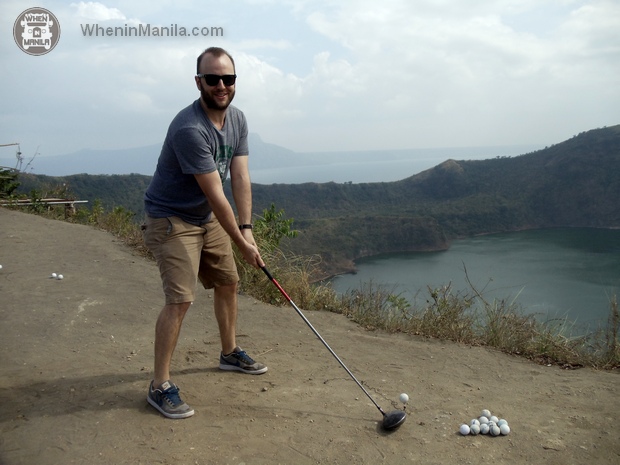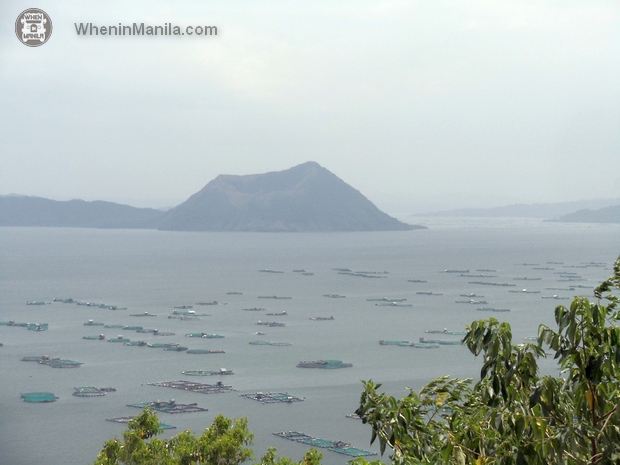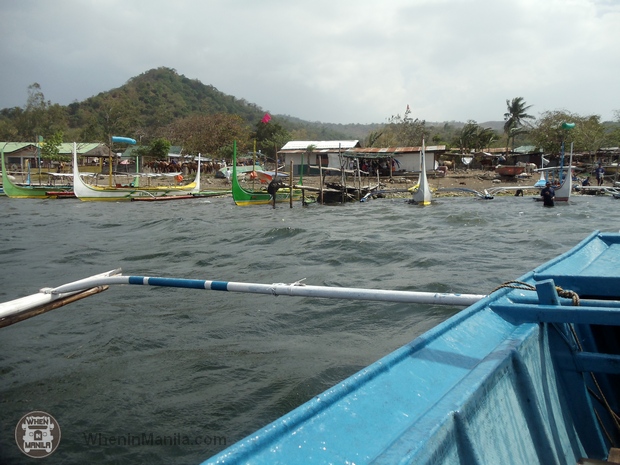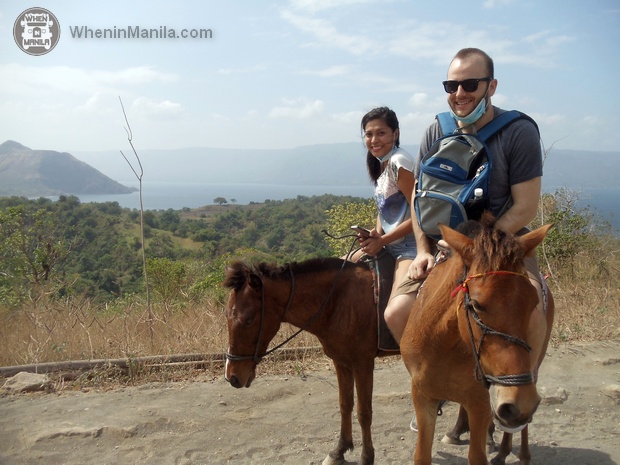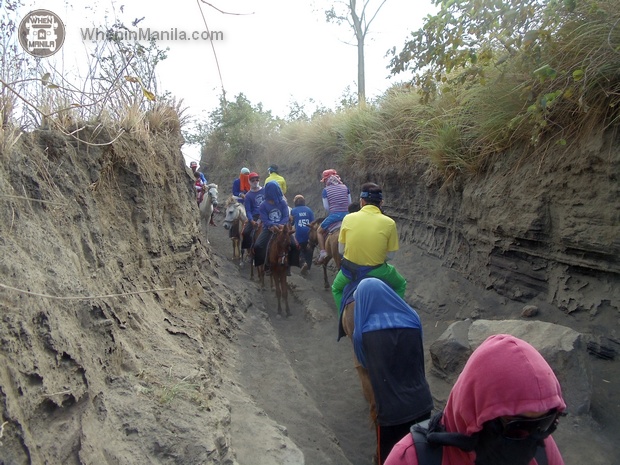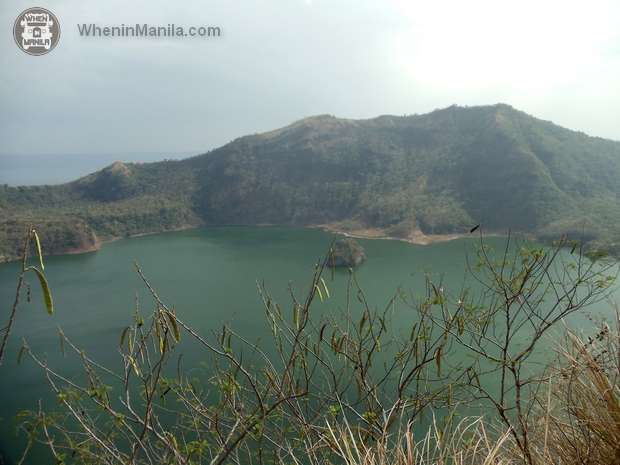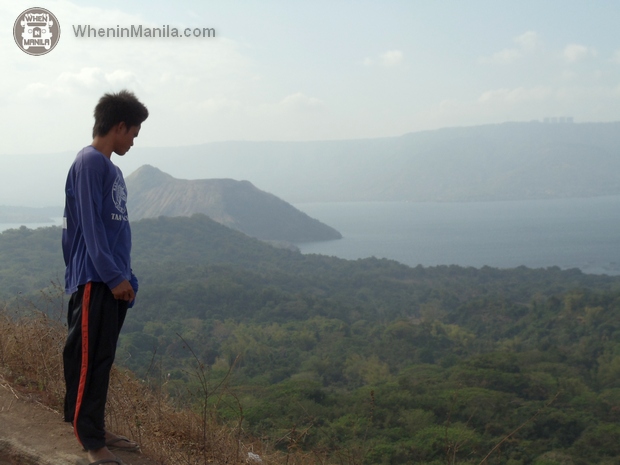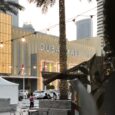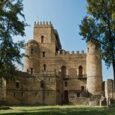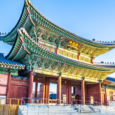Golf at Taak: Hit a Golf Ball into Taal Volcano For All of Humankind
I’m standing on the edge of the Taal Volcano and looking down into its crater. I can see the lake below bubbling near the shore, a reminder that the volcano is active and that the beast isn’t dead, just sleeping. Those geothermal gases escaping from the earth’s core are like the gentle breathing of a tantrum-prone child in the middle of a long, peaceful nap, a nap which is inevitably going to end.
The fact that we have no idea when the volcano will erupt again, only that it will, is a reminder that there are some things we still can’t know, and those things can hurt us, they can batter us the old fashioned way – with fire and brimstone. This volcano has taken thousands of human lives.
It is with this sense of personal fragility and inconsequence that I back away from the edge of the crater holding the driver I’ve just been given. For 100 pesos the man who gave it to me drives a tee into the soft volcanic dust at my feet and gently balances a golf ball on top of it. I nod at him and try and line up my shot, my heart starting to race as I steal a look around and see a few dozen Korean and Japanese tourists politely stop their chatter and wait for my drive. Head down, I remind myself. I bring the club back and take a nice easy swing. The ball flies high into the air; its arc is straight and I feel immensely and disproportionately proud for what is essentially a very average drive. I hear a smattering of polite country club applause as I watch the ball fall until it disappears into the lake at the center of Taal Volcano.
I don’t know many places where you can hit a golf ball into an active volcano. But you can at Taal Volcano. When in Manila and feeling the need to assert your humanity against the cold indifference of the universe, go hit a golf ball into the Taal Volcano. It feels good, like landing a punch for humanity against father time. It’s like giving outer space the finger. It’s like farting in the ocean. And to get there you can ride a boat and what may or may not be a horse, all the while enjoying some of the most beautiful views you will ever see.
Taal Volcano is located about 50km south of Manila. It has been classified “high risk” by experts due to its history of destructive eruptions and its proximity to populated areas. Its current structure was a result of a series of eruptions that lasted from the mid-sixties until its last eruption in 1977. (In 1911 an eruption killed more than a thousand people and spewed ash all the way to Manila). The most interesting thing about the volcano is that it sits in a sort of Russian-nesting doll of volcanic structures. Taal Lake is on the island of Luzon, which is part of the Pacific ring of fire. Taal Lake is a volcano crater. Taal Volcano is on Volcano Island, which is on Taal Lake. And then there is Crater Lake, which is inside the volcano’s crater on Volcano Island, which is on Taal Lake, which is on Luzon. Got that? Just remember I went to a lake inside a volcano on a lake made by a volcano.
The best way to see Taal Lake and Volcano Island, where the eruptions come from, is to take a tour from Tagaytay, which is easily accessible by bus from Manila. My friend Teena and I traveled from Manila and stayed at the Theodore Hotel in Tagaytay in order to make the trek to the top of the volcano. From our room we could see Volcano Island and the two other smaller islands to the east of it, Babuin Island and Napayung Island.
We were fortunate enough to have Ian Rom from the hotel staff give us the hotel’s volcano tour. Ian could not have been nicer, more accommodating, or more knowledgeable about the volcano. Teena and I met Ian in the lobby around one o’clock on a recent sunny Saturday afternoon. We then boarded a private van that snaked down the winding mountain road to Talisay, a picturesque lakefront community just over the border between Cavite and Batangas.
During the twenty minute ride from Tagaytay, Ian and our driver told us about the history of the volcano, how it was still active, and how it was constantly being monitored by scientists for any fluctuation in seismic activity. When we arrived in Talisay, we pulled into the Theodore Hotel’s sister waterfront resort, Villa Khristalene.
We then made our way down the resort’s dock and boarded a long and narrow boat painted white and blue. The captain steered us away from the little harbor and a bunch of naked boys playing on a tiny beach waved at us as the captain gunned the engine and we sped toward Volcano Island.
I tried to take pictures during the ride to Volcano Island, but I quickly realized the boat was happily bouncing and slapping the water as it went, making balancing a camera or staying dry impossible. Teena and I were in the front of the boat and we were on the receiving end of small splashes every few seconds, which provided a refreshing respite from the hot sun. Ian was thoughtful enough to offer us a tarp, but we declined. By the time the twenty five minute boat ride was over, we were cool and pleasantly damp but not soaked, like we had just been in a squirt gun fight against a gang with poor aim.
When we got off the boat, Ian explained that the residents living on the beach technically weren’t supposed to be living here, since there was an active volcano looming overhead. But the soil here was particularly fertile thanks to the nutrient-rich volcanic ash below our feet, so they stayed. There were boats lining the shore, and a small grassy town square that we entered as we stepped off the beach. Ian, carrying a cooler of drinks and sandwiches, as well as his own backpack, quickly directed us through the many vendors hocking hats, beers, and surgical masks (a precaution I didn’t yet understand), and brought us to the horses.
Now, I’m no animal expert, nor am I a cowboy. But I have ridden a horse before. And I’ve seen horses up close. And these were the smallest horses I’ve ever seen. In fact, I’m not sure they were horses. I felt like I was bigger than my ride, whose name was Coco. I actually felt bad about riding her, like she might collapse under my American girth. There’s nothing like riding a tiny horse to make you feel fat. But I think these were donkeys. Or maybe ponies. I tried to ask whether they were real horses and everybody looked at me like I was crazy, as if I was asking if we were riding two dudes inside a horse costume.
I got on the “horse” and expected to be handed the reins by the guy who helped me on, one of the dozens of workers in long-sleeve blue t-shirts standing around the trail entrance. But instead of handing me the reins, he started leading the horse, and me, through a small village, by a basketball court, and finally to a wider trail. I thought he was going to hand me the reigns when we were out of the town, but he continued to pull the horse and make clicking sounds to keep it moving. I realized that he was going to bring me, on the horse, all the way to the top. At this point, feeling guilty about having someone else run up a volcano next to me while I relaxed on my tiny steed, I tried to offer him water and ask him his name. He kind of waved me off with a smile, as he was clearly more concerned about navigating the trail, with its ragged rock faces and dangerous looking crevices, then making friends with the overweight American who he had to find a way to get to the top before poor Coco had an aneurysm.
At one point he told me to put my backpack on in front, and when I did he gracefully jumped behind me on my horse (“I’m sorry, Coco,” I whispered). Then he held the reins out in front of me as he navigated the flatter stretches of the trail before hopping to the ground and leading Coco over steeper parts.
As we made our way up the volcano toward the crater, I realized a couple of things. The first was that the scenery was magnificent all around; we could see the sun shining on the lake and coloring the dormant volcano shell at the end of the island bright green. I could even see the faint outline of some of the buildings in Tagaytay that were perched on the horizon above the lake. The other thing I realized was that Coco, and all the other horses we passed and were passed by, kicked up a lot of rich volcanic dust. With one hand hanging onto the saddle’s horn, I managed to get a surgical mask out of my pocket and loop it around my ears. And I thought breathing Manila traffic was bad on the lungs.
There were hundreds of guides bringing tourists like us up and down the mountain. All of the tourists were wearing surgical masks, and nearly all of the guides had wrapped their heads in t-shirts and cloth to protect their faces from the dust. Most of them had on dark sunglasses as well. If you didn’t know what was happening and you stumbled out of the woods and saw this, you might assume that some strange group of color coordinated bandits had taken a surgical convention hostage, and were now leading them to their volcanic hideout.
The ride was probably about half an hour, but it flew by because it was fun, the day was beautiful, and Coco seemed in good spirits. I kept craning my neck to see the view behind me and almost falling off.
As we were fifty or so feet from the top of the volcano, we dismounted at a small camp. We looked around for Ian but couldn’t find him anywhere. Teena and I had somehow gotten ahead of him on the trail, and since we weren’t the ones in control of our horses, we couldn’t wait for him.
After a few minutes he arrived and came up to us, holding the cooler, which he refused to let me carry no matter how many times I asked, and still covered head to toe in denim and thick cotton. We asked him how he got so far behind.
“I got a pregnant horse,” he told us.
I did not feel bad for Coco anymore.
We then climbed the stairs to the top of the ridge, where this little guy was waiting for us.
The lake at the bottom of the crater was emerald green. Ian was relaying facts and figures about the crater to me and he pointed out an area near the shore where the water seemed to be gently boiling. He explained that since the volcano was active, a cocktail of elements bubbled though the crust and made the water on Crater Lake churn. It also left some greenish-white residue on the shore. I was marveling at all of this and the incredible views beyond the volcano of Taal Lake’s far shore, realizing how volcanos shaped this whole area, this whole part of the world, and how a volcano is a place where we are reminded of our fragile and our pathetically short lives. The volcano is the creator and the destroyer.
That was when a man came up to me and handed me a driver.
There is such a tiny part of the earth that life can inhabit. There is only a tiny sliver of crust and atmosphere between the infinite cold and airless nothingness above and the hellish fiery heart of the planet that beats beneath our feet. And that tiny terrestrial lease is all the property we have. Every once in a while a volcano erupts and we are reminded of how dangerous the earth is and how insignificant we are. But people live here, this site of potential disaster, and they offered me coconuts to drink from and shirts to buy and we were all happy, enjoying the countdown to disaster.
Because that’s what life is really, when you think about it, one long countdown to an inevitable disaster, not an “if” but a “when.” And sometimes you get to stand on top of an active volcano and see far into the distance with new friends, knowing that it’s going to be over someday, but not before you hit a golf ball into a volcano’s goddamn mouth.
Oh and do check out our the hotel we stayed at, the Theodore Hotel in Tagaytay, who set up this cool sightseeing trip – https://www.wheninmanila.com/the-theodore-hotel-in-tagaytay-spectacular-sights-both-inside-and-out/
Thanks as well to Agoda.com for helping us book this hotel with an amazingly affordable discounted rate!
Agoda
Facebook: https://www.facebook.com/agoda

